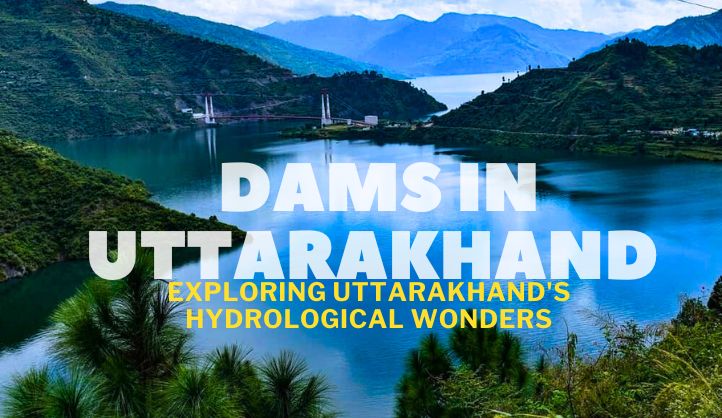Dams in Uttarakhand- Uttarakhand, a beautiful state in the Himalayas, has many big structures called dams. These dams are like giant walls built across rivers to collect water. They are super useful because they make electricity, help farmers water their crops, and manage the flow of water. Each dam has its own special job, and together, they make Uttarakhand a powerful and resourceful place!
Tehri Dam:
Location: Tehri Dam is situated on the Bhagirathi River near Tehri town in the Tehri Garhwal district of Uttarakhand.
Purpose:
- Hydroelectric Power Generation: The primary purpose is the generation of hydroelectric power. The Tehri Hydropower Complex comprises several power stations, including the Tehri Dam, Koteshwar Dam, and Tehri Pumped Storage Plant.
- Irrigation: It facilitates irrigation in the surrounding areas by regulating the flow of the Bhagirathi River.
- Drinking Water Supply: The dam also provides drinking water to the nearby towns and cities, including the national capital region.
Key Features:
- Height: Tehri Dam is one of the tallest dams in the world, with a height of over 260 meters.
- Reservoir: The reservoir, known as Tehri Lake, has a significant capacity and has become a tourist attraction.
Rishikesh Dam:
Location: Positioned on the Ganges River near the spiritual town of Rishikesh.
Purpose:
- Hydroelectric Power Generation: The dam contributes to the production of hydroelectric power.
- Flow Regulation: It helps regulate the flow of the Ganges River, ensuring a consistent supply downstream.
Key Features:
- Tourism: Rishikesh is not only a significant dam but also a renowned tourist destination, known for its spiritual and adventure tourism.
Dharasu Power Station:
Location: Located on the Bhagirathi River in the Uttarkashi district.
Purpose:
- Hydroelectric Power Generation: Dharasu Power Station is part of the larger hydroelectric complex harnessing the energy potential of the Bhagirathi River.
Key Features:
- Run-of-the-River: As a run-of-the-river project, it minimizes the environmental impact on the river’s natural flow.
Koteshwar Dam:
Location: Downstream of Tehri Dam on the Bhagirathi River.
Purpose:
- Hydroelectric Power Generation: Koteshwar Dam contributes to the overall hydroelectric power generation capacity in the region.
Key Features:
- Integrated System: It is part of the integrated Tehri Hydro Development Corporation’s projects, working in conjunction with Tehri Dam and other structures.
Ramganga Dam:
Location: Situated on the Ramganga River.
Purpose:
- Hydroelectric Power Generation: The dam is a key component of the Ramganga Multipurpose Project, generating electricity for the region.
- Irrigation: It supports irrigation activities in the downstream areas.
Key Features:
- Water Management: The dam aids in effective water resource management in the Ramganga River basin.
Maneri Dam:
Location: Maneri Dam is located on the Bhagirathi River, downstream of Gangotri, in the Uttarkashi district.
Purpose:
- Hydroelectric Power Generation: The dam is part of the Maneri-Bhali Hydroelectric Complex, contributing to power generation in the region.
- Irrigation: It aids in irrigation by regulating the flow of the Bhagirathi River.
Key Features:
- Altitude: Maneri Dam is situated at a high altitude, adding to the complexity and engineering significance of the project.
Kalagarh Dam:
Location: Kalagarh Dam is on the eastern fringe of the Corbett National Park, across the Ramganga River.
Purpose:
- Hydroelectric Power Generation: The dam is part of the Ramganga Multipurpose Project and contributes to power production.
- Water Supply: It provides water for irrigation and drinking purposes.
Key Features:
- Wildlife: The dam’s proximity to Corbett National Park makes it an area of ecological significance.
Lakhwar Dam:
Location: Lakhwar Dam is planned on the Yamuna River in the Dehradun district.
Purpose:
- Hydroelectric Power Generation: Lakhwar Dam is part of the Yamuna River Development Project, aiming to harness the hydropower potential of the river.
- Water Supply: It is expected to provide water for irrigation and other purposes.
- Key Features:
Multi-Purpose Project: Lakhwar Dam is designed as a multi-purpose project to address various needs, including power generation and water supply.
Pancheswar Dam:
Location: Pancheswar Dam is planned on the Sharda River, which forms the border between India and Nepal in the Champawat district.
Purpose:
- Hydroelectric Power Generation: Pancheswar Dam is a joint project between India and Nepal, and it aims to generate hydroelectric power.
- Irrigation: The dam is expected to provide water for irrigation in both countries.
Key Features:
- International Collaboration: Pancheswar Dam is a symbol of cooperation between India and Nepal for the joint development of water resources.
Srinagar Hydroelectric Project:
Location: Srinagar Hydroelectric Project is on the Alaknanda River near Srinagar in the Pauri Garhwal district.
Purpose:
- Hydroelectric Power Generation: The project contributes to the power generation capacity in the region.
Key Features:
- River Alaknanda: The dam harnesses the energy potential of the Alaknanda River, a major tributary of the Ganges.
Conclusion
The “Dams in Uttarakhand” tour is like a big adventure. You’ll see huge dams that do amazing things like making electricity and helping farmers. These dams are like nature’s helpers, making sure everything is okay.
It’s a fun trip where you learn how people use clever ideas to work with rivers and mountains. Uttarakhand is like a superhero, using dams to give power to homes and keep everything in balance. Come with us on this cool journey and discover the awesome world of Uttarakhand’s dams!
FAQs Related to Dams in Uttarakhand
1. Why are dams important in Uttarakhand?
Dams in Uttarakhand serve crucial roles, generating power, managing water, and supporting agriculture.
2. How do dams impact the environment?
While providing essential services, dams can alter ecosystems and affect local flora and fauna.
3. Can tourists visit these dams?
Access varies, but some dams offer guided tours, providing insights into their operations and scenic surroundings.
4. What is the significance of hydroelectric power in Uttarakhand?
Hydroelectric power from dams is a major energy source, contributing to the state’s power supply and economic development.
5. Are there safety considerations for dam visits?
Yes, visitors must adhere to safety guidelines, as dams are operational sites with specific rules and regulations.






